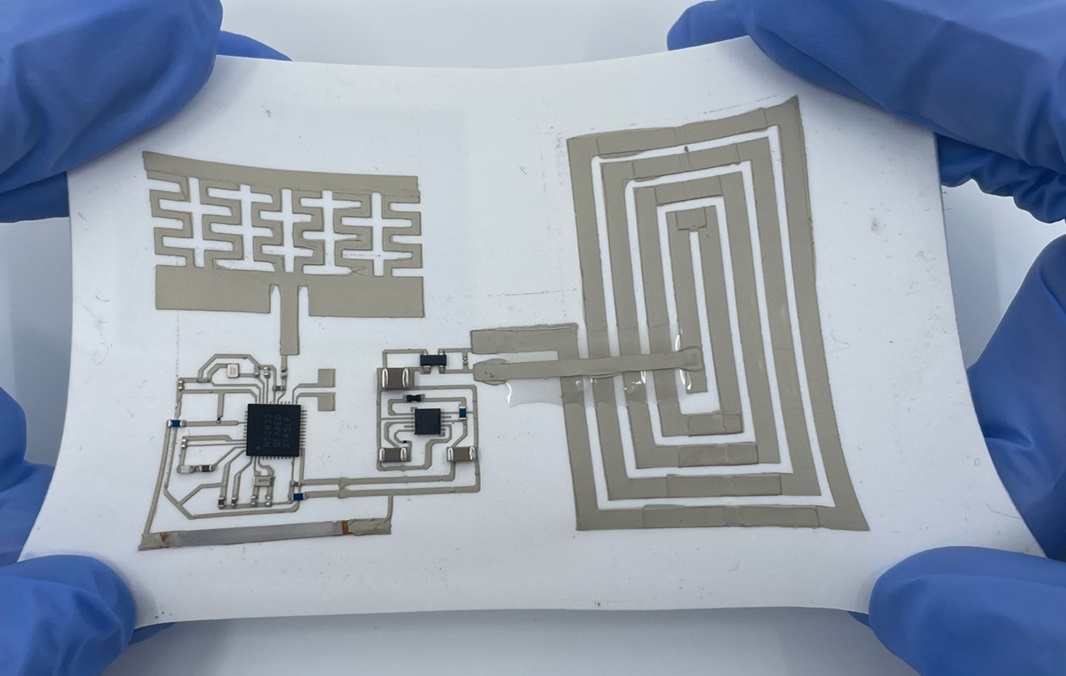
국내 연구진이 잡아당기거나 늘려도 무선통신이 유지되는 새로운 기판을 세계 최초로 개발했다. Domestic researchers have helped develop the world’s first elastic substrate that maintains wireless signal communication even if pulled or stretched.
과학기술정보통신부는 22일 한양대학교 정예환·유형석 교수가 이끄는 공동연구팀이 세계 최초로 고무처럼 신축성을 가지면서도 무선통신 성능은 그대로 유지하는 ‘전자 피부’ 개발에 성공했다고 밝혔다. 연구 결과는 21일(현지 시간) 국제학술지 ‘네이처’에 게재됐다.
The Ministry of Science and ICT on May 22 said the team of researchers from Hanyang University in Seoul and Rice University in Houston developed an “electronic skin” with rubber-like elasticity that maintains wireless functions. Two of the lead authors of the study are Hanyang professors Jung Yei Hwan and Yoo Hyoungsuk. The research results were published on May 21 in the international academic journal Nature.
의료나 건강관리 등 다양한 분야에서 쓰이는 전자피부 기반 웨어러블 기기는 외부와 통신하고 전력을 전송받을 수 있는 무선 주파수(RF) 소자와 회로가 필수다.
Wearable devices based on the electronic skin used in fields such as medicine and health care need radio frequency (RF) elements and circuits that communicate with the outside and transmit power.
하지만 RF 회로는 고주파에서 동작하는 특성상 아주 조금만 늘어나거나 구부러지기만 해도 회로의 작동 주파수 대역이 변해 통신이 끊기거나 전력 송‧수신 효율이 급격하게 낮아지는 한계가 있다.
Due to the nature of RF components operating at high frequencies, however, communication is interrupted and power transmission and reception efficiency plummet in the event of even slight stretching or bending. This drastically changes a component’s operating frequency band.
공동연구팀은 이를 극복하기 위해 신축성을 가진 고무 재질 소재에 세라믹 나노입자를 섞은 후 나노입자가 기판 내부에서 뭉치며 조립되는 공정을 적용한 기판을 개발했다. 그동안 학계에 보고되지 않은 세계 최초의 기술이다.
To overcome this obstacle, the team developed a substrate mixing ceramic nanoparticles with elastic rubber material and used a process of assembling the nanoparticles by clumping them together within the substrate. This was a world first never before reported in academia.
연구팀은 개발한 기판을 응용해 90m 이상 장거리에서도 무선 통신이 가능한 전자피부도 개발했다. 이 전자피부는 기존 기술에서 측정이 어려웠던 뇌파나 신체 움직임, 피부온도 등 인체 신호를 원거리에서 측정하고 전송하는 데도 성공했다.
The electronic skin applied to the new material enables wireless signals even at long distances of 90 m or more by applying the substrate. The skin measures and sends body signals such as brainwaves, physical movements and skin temperature even from long distances, tasks difficult with conventional technology.
김혜린 기자 kimhyelin211@korea.kr
By Kim Hyelin, kimhyelin211@korea.kr
